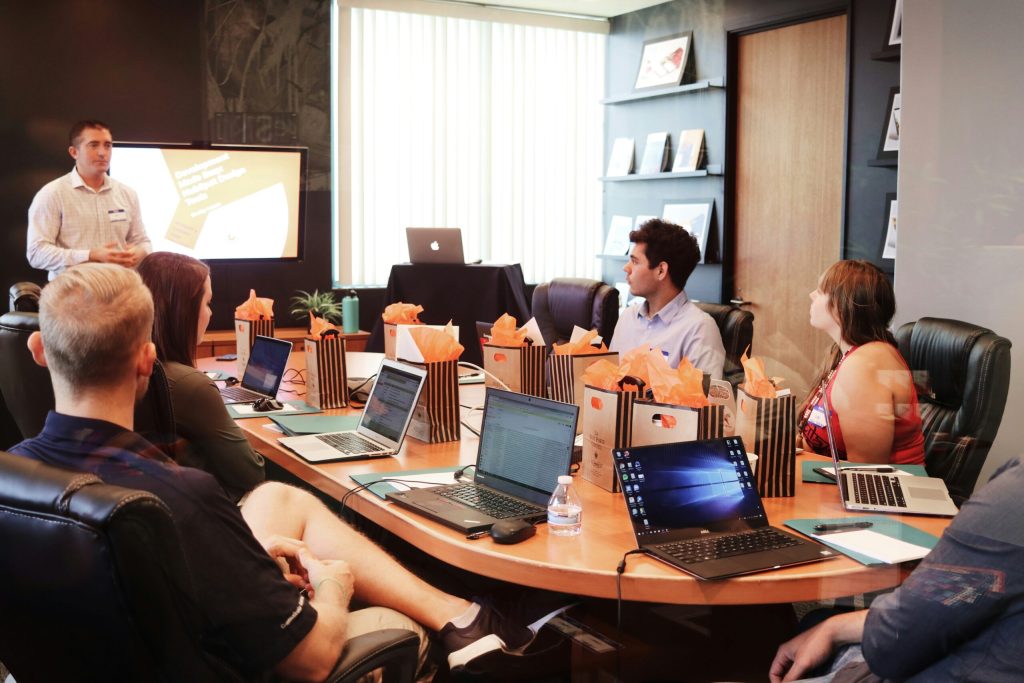Key Takeaways from our recent Inpulse Masterclass!
Last Thursday (15th of October), we hosted a free online Masterclass on the 2 Critical Areas to Focus on Now and into 2021to grow your employee engagement.
Our Founder, Matt Stephens chatted to Bertie Tonks, Global Director of People and Culture at Collinson, and Paula Leach, Chief People Officer at FDM, and found out:
- The people-related challenges they faced this year
- What they discovered about their people; and how they got on top of the challenges
- The lessons learned, and what they’ll carry with them into 2021
Taking a deep-dive into the above-mentioned points, we discovered the 2 critical areas to focus on now and into 2021 to grow engagement (and nurture wellbeing)! Read on to find out more.
KEY TAKEAWAYS FROM THE INPULSE MASTERCLASS
EMPLOYEE WELLBEING and ENGAGEMENT
For a long time, employee wellbeing has been somewhat of a ‘trendy’ term amongst HR/People leaders, however, after this year, it has become front and centre for the vast majority of organisations. Leaders have quickly recognised the relationship between wellbeing and engagement (nurturing wellbeing drives engagement). Our speaker agreed that when their people feel looked after, they feel more motivated to engage and deliver.
As you can tell, we’ve mentioned the word ‘feeling’ often, and that’s because wellbeing and engagement is an emotional state, and it’s why we measure emotional analytics.
In response to the current climate, Inpulse, in partnership with a leading UK health provider, developed a wellbeing framework to help organisations address vital areas and support their people for the benefit of improved wellbeing and engagement.
We worked alongside health professionals to ensure we asked the right questions under each segment of the wellbeing framework.
Download Inpulse’s Free Guide on Leading through Change
Bertie Tonks, Head of People and Culture at Collinson | 1800 employees, 24 global locations
Challenges faced this year:
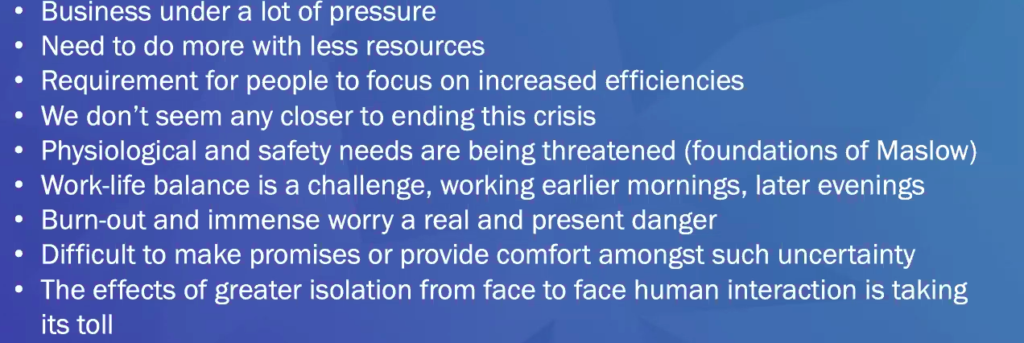
Being in the travel industry, they were ‘hit hard’ by the effects of Covid-19. Business was slower than usual, redundancies were palpable and their workforce was, of course, forced to abruptly shift to remote working. With teams working from home, leaders had ‘no idea how their people were doing’. Out of Bertie’s direct team of 22, 6 team members experienced death of loved ones, while the scale of change (personal and work-related) added to employee anxiety. Leaders were required to step up and support their people during a time that made it difficult to do so.
How they ‘got on top’ of the challenges:
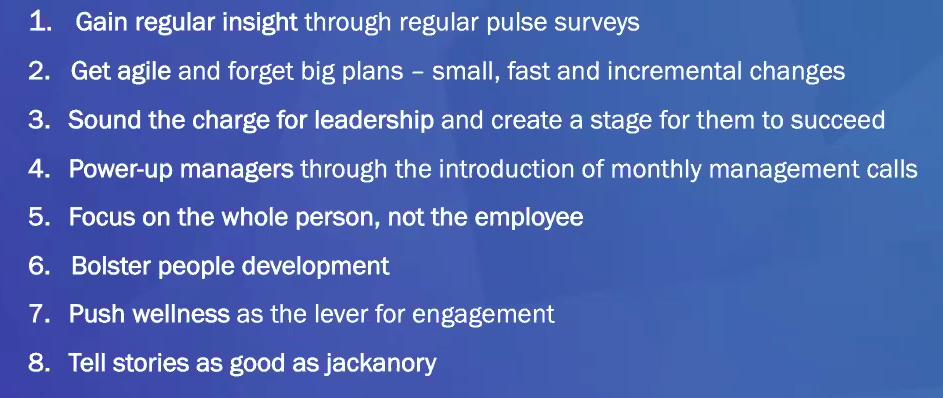
Luckily, Collinson implemented practises and began ‘pulsing’ 2 years ago, which better prepared their people for change and made the difficulties easier to work through. They again, depended on pulse surveys to find out how their people were feeling, so as to provide the right support at the right time.
Lessons learned:
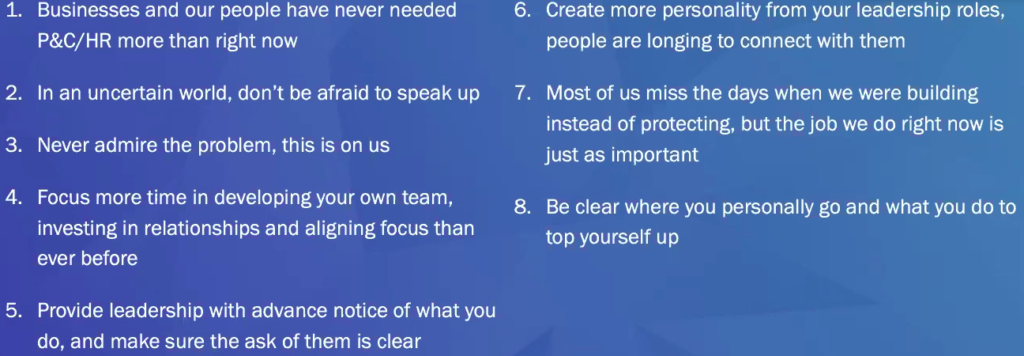
Headline results after measuring and driving employee wellbeing and engagement
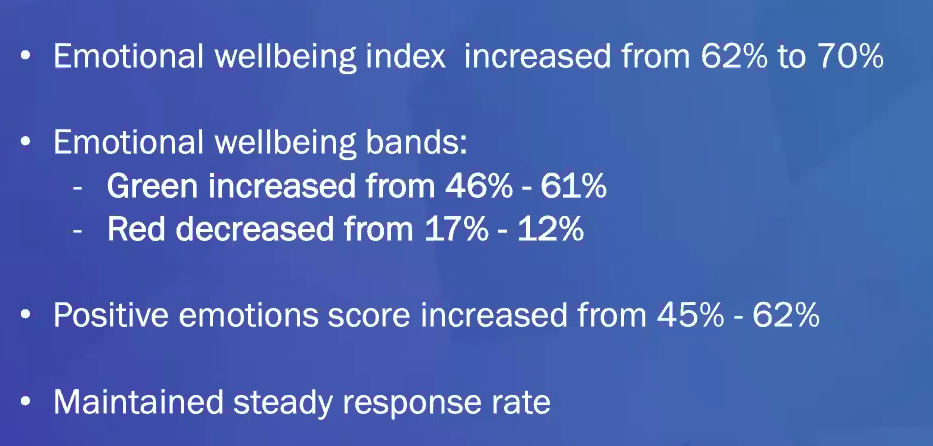
After implementing monthly pulse surveys and taking the right action in accordance with results, Collinson saw a significant improvement in key areas such as their emotional wellbeing index (+8%)
Their emotional wellbeing bands (which indicates general wellbeing of their people - green being very good and red being problematic), improved significantly.
Positive emotions were up, and a steady survey response rate was maintained.
Bertie Tonks recommends a critical area to focus on is leadership, and providing your leaders with the support they need to lead the workforce effectively. Another, is recognising that these uncertain times are threatening your people’s hierarchy of needs (particularly their physiological and safety needs), and leadership, support and communication is critical.
“We wouldn’t know where we’d be without pulse surveys. Monthly pulsing allowed us to stay quick and agile and created a stage for our leadership team to really show our people that we care.” - Bertie Tonks
----
Paula Leach, Chief People Officer of FDM | 5500 employees, UK and abroad
Challenges they faced this year:
The substantial societal, economic and cultural change this year saw the organisation move through three different ‘phases’.
- ‘Stop’ - Going into lockdown, everyone experiencing the same thing.
- ‘Messy middle’ - experimenting with going back to work, employee emotions were ‘tangled’, people are unsure of what’s around the corner and they want clarity.
- ‘Maze’ - oscillating between restrictions, but there’s a sense of acceptance but are aware they’ll need to exercise agility when approaching change.
In each phase, varying degrees of support was needed by their people and leaders had to make quick decisions to minimise the impact of change and protect employee wellbeing and engagement.
How they ‘got on top’ of the challenges:
During the first phase, they focused particularly on employee wellbeing:
- Conducted pulse surveys
- strengthened communication channels
- hosted virtual events
- appointed wellbeing and mental health coaches for their people
During the second phase / ‘messy middle’, FDM further strengthened communication
- They encouraged talking and listening
- They recognised the emotional impact of change and set about untangling the ‘mess’ to provide as much clarity as their people needed.
During the third phase ‘the maze’, FDM focussed on planning and mapping out the way forward
- Conducted workshops
Lessons learned:
Their survey results showed varying levels of emotion across the organisation. FDM learned that not all of their people felt the same way - while some were managing the change well, others were not. After learning this, they communicated these results with their workforce, and reminded their people that some may feel positive but their colleagues may feel differently and that they needed to show support. FDM also appointed mental health coaches for additional support.
Survey takeaways:
Results of their surveys showed feelings that were dominant (more than 10%), as well as feelings that were bubbling under the surface (less than 10%). With these results they were not only able to monitor the success of their implementations/changes, but understand the problematic emotions that needed attending to, to avoid them becoming dominant.
Paula advises we place a key focus on communication - understanding what our people need from us is incredibly important for their wellbeing, and for leaders to make decisions they're confident in. But she says, leaders must not be hard on themselves, no one has the answers in times like these, but there is a sensible way of going about leading through change - communication!
“Early and repeated surveys gave us all a better sense of awareness and connection, and we as leaders were able to test how effective we had been with our priorities.”



